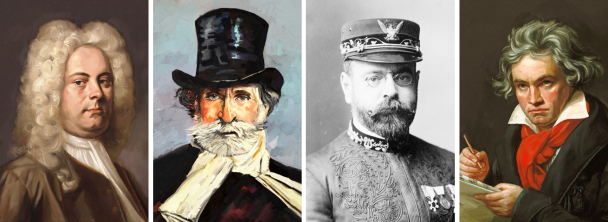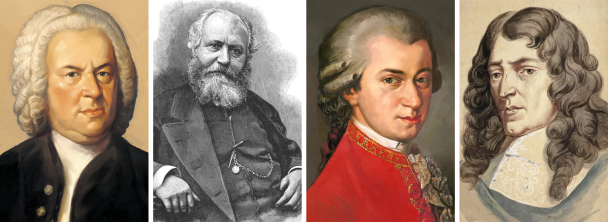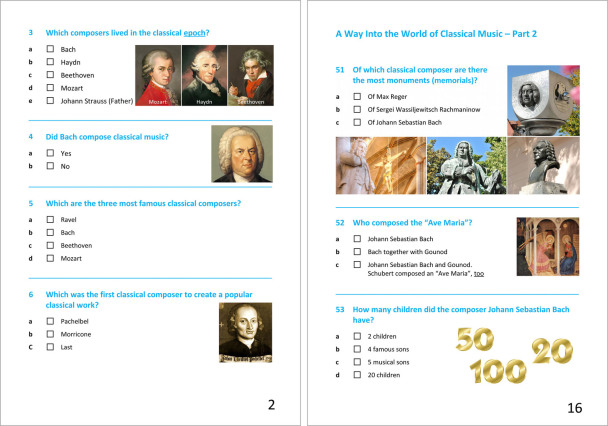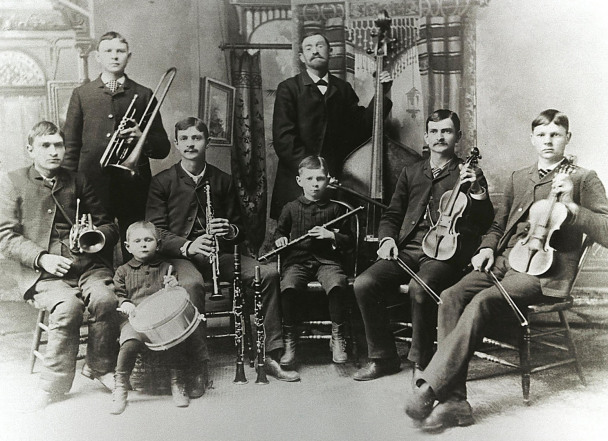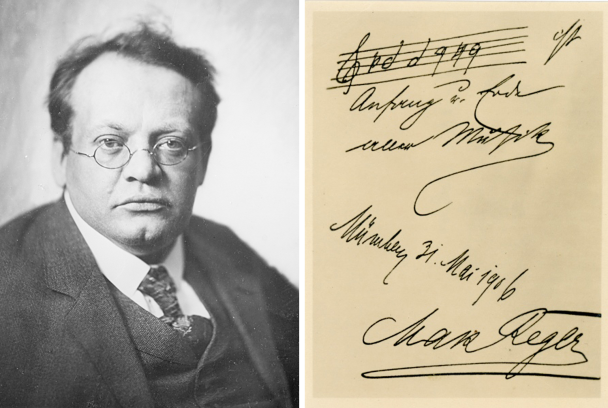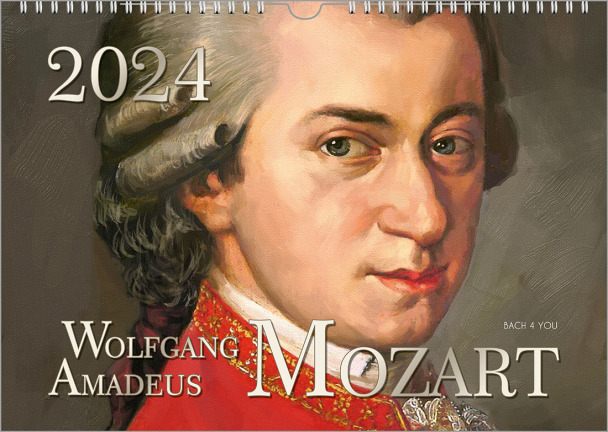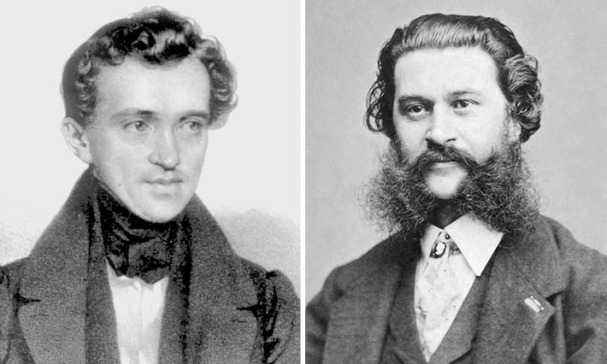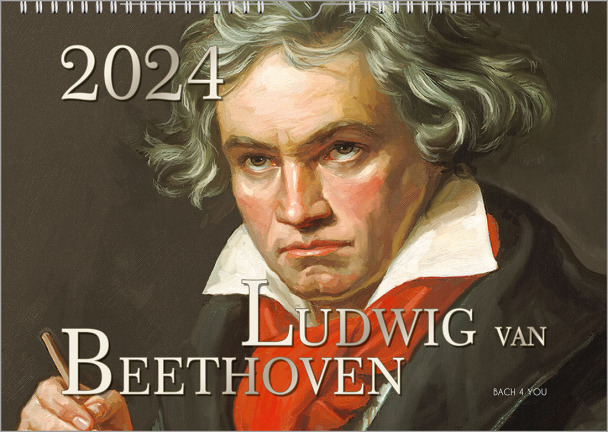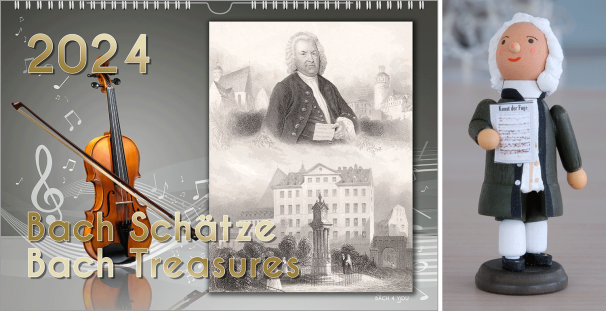
This Whole Page Is Advertisement = Promotion = Commercial
The Cool Offer for Teachers: “Classical Music Teaching Material” and “Popular Classical Music Teaching Material” Respectively
Teaching Material Classical Music for Teachers? More precisely? For whom else could teaching material be good? Right! Then: Basically I would like to encourage teachers to introduce their kids to the "real" Classical Music with my way via the Popular Classical Music very carefully. Do you also teach music? Then give my approach at least a chance and try "a round" with my suggestions. I think I have discovered a "tool" that finally gives teachers a real option to introduce Classical Music in a way that some of the dwarfs could enjoy this genre of music for a lifetime. And what is so special about it? Well ... Bach, composers, Classical Music, pictures, entertainment ... it is simply a colorful mix on the topic, just like on a marketplace.
"Teaching Material Classical Music": Sure, you probably know three of the gentlemen above. But do you also know the third expert from the left?
Click here directly to the entertainment and read about the "Teaching Material Classical Music" later!
“Teaching Material Classical Music”: If I Can Make You ( ! ) Happy With It ... Would You Please Try It With Your Kids Too?
All my approaches and publications are definitely "outside the box" ... in German: "quergestrickt" (... sort of cross-knitted). Even Anglicisms – even inside the German text – are consistently represented, because I love them. And the usual text already exists in so many publications. Let's consider a "deal": If I succeed in making you smile and be amazed in the coming sections (... under the short description of the teaching material), then try it "for a round" to approach your kids with my way of doing things. Instead of the other usual options that publishers have been offering for decades and the rest of the internet has been offering for 20 years already. In advance, however, here is a short note about this, my "Teaching Material Classical Music ".
There is – firstly – the free "light variant": That's six components. You prepare yourself by exploring my definition of "What is Classical Music?" on a special website. Here in addition you use the exciting compact knowledge, which follows now on this side. Then on the above mentioned website is also a collection of 300 popular Classical Music works that are so perfect for an introduction to this genre. I call them my "Classic Top 100." And finally, you can use – in your classroom – a compilation of the most popular Bach works with a running time of about 45 minutes as an MP3 file to provide a theme-based background to your lessons. A little further down, a notes button will take you directly there.
Hundreds of music gifts? We think you probably will rather find thousands of music gifts on my five internet platforms. To the shops.
The Protection Fee for the XXL Version Spread Over Ten Years: That's the Equivalent of Only € 1.19 per Year ... My "Teaching Material Classical Music" for You
Why actually is this whole page an advertisement at all? Because I want to be quite sure that even with such a small amount as the nominal fee for a tremendously exciting and extensive offer in the matter of "Teaching Material Classical Music " of only € 11.90, a separation of advertising content (... the ads, that is the promotion), for example on this page of the website, and the largest part of the website, in fact the entertainment for kids separates in accordance with the law. And maybe also because you can order the offer from my wife's Publishing House. And this is the "commercial" part of our Mission ... for financing also in the future. With the hint at the very top of the page ... and also at the bottom ... I am therefore legally "on the safe side" ... and you are "warned"!
So now to the teaching material XXL on my "marketplace" in terms of Classical Music for teachers. By the way, this offer addresses your kids from the third to the sixth grade. Possibly also up to the eighth grade ... please decide for yourself.
For your entertainment, you will first get this further reading of interesting knowledge on the subject of Classical Music as well as the Bach music, as above in the light offer as well. Plus the background information "What is Classical Music exactly?" and the "Classical Music Top100" with its 300 musical works. Also as above.
Now follows the actual XXL package in terms of Classic and Popular Classic. Firstly, there is a "homework" the core, the question/answer combinations put together with much love. You can make it homework on one day or on six days or on two, three, four or five: 150 cool, easy questions with a lot of "aha experience", trick questions, practically already answered questions, exciting questions ... and all in multiple choice answer style.
A next chance for you: Who is who? No. 1 and No. 3 is general knowledge. The gentleman between Bach and Mozart is no longer quite so. But the colleague on the far right ... that's something completely different!
That's exactly what the 150 questions on 47 pages look like. And that's almost exactly how the test, that is the class assignment, looks.
For Your Face-to-Face Classes or Online ... And All With Minimal Work for You: My Teacher Offer "Classical Music" and "Popular Classical".
The above filled in homework sheets filled are handed over: on paper or as an electronically filled in PDF or simply photographed or scanned with a cell phone and sent to you. But: You do not correct them. Instead, you dispose of them: That's part of the project. And quite (... un)secretly, your kids have been in touch with Classical Music for quite a while.
This is followed by the test, or respectively the class work ... as a PDF sent to your kids, online or in a face-to-face class ... over one class hour, or simply over two ... or more. The fact that in between and again and again "cheating" can be done is (... unmentioned) part of the project. The subject " Classical Music" should simply not cause any stress, should not be associated with pressure.
Back to the test, the class work. The questionnaires for this are slightly graphically modified: So your kids can't send or hand in the "homework" to you a second time. The test can also be divided into one to six approaches. Depending on what you think is reasonable. As in American tests, the questions are 100 percent the same as the "first pass," which is the homework assignment. You also collect this test, this classwork, or have it sent to you (... as PDFs or photographed or scanned). At the top right of the test is again a field for the student's name. You now give the name a number, and then cut the name off. But you do not correct these sheets yourself and not alone!
In the third phase of the lesson, you distribute the sheets to your kids again. Because you have replaced the names with numbers and the names have been cut off or deleted, each child corrects the work of a classmate. Without knowing whose result he or she is evaluating. You go through question by question together with your kids and get a compilation of about 125 facts from me, with which you – as entertainment – break up the pure correction and scoring. Each correct answer, judged very generously, results in one point. At the end, your students add up the points and the winner is decided. This "answer-and-info" activity was the most challenging part of the project, and you can now decide how you want to work with your rascals: You pull up the scrolling answers on your laptop or other device. And scroll to it. Via teleprompter, it's only one answer at a time, and it's much larger on the screen: so you always click in the same place. Instead of scrolling: This has advantages in "practical operation". The third offer is my moderation for you. I entertain your kids, this video is enriched with music and illustrations and of course you can stop it for a break (... that part is not necessary ... in English it will be released in 2024). And it works in school, in online learning, in homeschooling, in alternate teaching and in any mix of it. Even at a classroom table, one student can work with paper, the other environmentally friendly digital.
In order to make the introductory or further lessons different and even more exciting, it is planned to play Popular Classical Music in the background. A loudspeaker for your laptop, smartphone or tablet is available from around €10. In addition, you can use my 45-minute Bach music special in the light version. In addition, you will receive from me four lists of other popular music titles, which are particularly suitable for a now second contact, but now with works by many Classical Composers. These four lists can be combined to four playlists. Or a DJane or DJ plays piece by piece, each by clicking on the work title in the list. Unfortunately, I am not allowed to compile a playlist or even an acoustic sequence of the music titles for you. That's what the "rules of the game" of the GEMA with all German schools provide. Bach "I am allowed to", because I produced the music by him myself (... and I am not affiliated with GEMA) and Johann Sebastian is dead for a while. GEMA in Germany is the National Association for Music Education in the USA. Please read about your permission to use copyrighted music (... not my production of Bach works, but everything beyond).
These collections of classical music works of 45 minutes each, compiled by your kids, you may ( ! ) use in this, your lessons. But you may not use them for anything else. You are not allowed to use them for a workshop outside, you are not allowed to play them at an event (... no matter if inside or outside the school), you are not allowed to give them – as a copy – to your kids and also not to your colleagues. The only thing you are allowed to do: Save them well, keep them and use them again and again for the same purpose in the coming year and also in the years after. So the already little effort for you is reduced again. You let this music run in the background to every lesson. In addition, your kids should also listen to titles from my "Classical Music Top 100" at home. Ten pieces in their entirety (... all are extremely short). Or 20 pieces at two minutes each, or 30 at 30 seconds each. Or three pieces from beginning to end every day for four weeks. Whatever! Important: These rules apply to the use of copyrighted music in Germany. However, I believe that the national institution mentioned above, GEMA, is the most powerful national institution of this kind in the world, and furthermore, Germany is probably the strictest institution in terms of compliance with these regulations. Therefore, other societies of this kind are very likely to follow this regulation. If in doubt, please check it out for yourself, because of course I am not allowed to give legal advice here. I have not.
The winner of the competition "Teaching Material Classical Music" will receive a certificate and additionally an audiobook and an e-book "Bach Biography for Children". The special thing: All classmates are also allowed to download this book, which costs around €20 in each version alone. And that as an audiobook, as an eBook and as a version for their laptops. And not "either/or" but in all three versions at the same time. Plus, that applies to every coming year with this one-time € 11.90 nominal fee. Only to colleagues and their kids we ask you, this generous suggestion, not to pass on. She or he should please buy her or his own "Teaching Material Classical Music " for the small nominal fee. By the way, the nominal fee serves to finance the very costly overall project and our common Bach Mission. As a thank you for the "field test with me", you as a teacher will receive my audio collage "The most beautiful quotations about Johann Sebastian Bach", underlaid with his music and enriched with a ten-minute short biography ... alone already in the value of round € 10. Incidentally, both of the above-mentioned productions are narrated by a professional, or the quote collage even by two professional speakers who can also be heard on the radio and on television.
Please read more about the philosophy of my approach "Teaching Material Classical Music ... the offer for teachers" below ( ! ) the now following entertainment in the subject of Popular Classical Music. Now I wish you first of all much joy and fun with this.
Many Bach Beer Steins, Many Pipe Organ Calendars
If this whole page is marked as advertising anyway, then I can also introduce you to my pipe organ calendar, which I designed and which is published at the "Bach 4 You" Publishing House. And there are many more motifs. Here you can get to "Bach 4 You" with one click.
First of All, Here’s Some Exciting Entertainment ... Next There’s – Below – My Very Special “Philosophy”
On the subject of musical families, "the Bachs clearly play the first fiddle". And what about the Kelly Family? They are not far away.
If I don't succeed in "engaging" you, in animating you to read on and in getting you to smile, how could I succeed with my offer for your kids? What do you think about "adding" Bach's music very quietly to your reading now? Just click on the button here and off you go. Please click on the button.
"Funny+++ Facts" is the name of one of my documents in the 20-part "Teaching Material Classical Music" and it is also a free portion. That means you can already "work" with the following entertainment without any effort. In the XXL set, however, it is then also available ... in the compact unit. And why the "+++"?
"Funny Facts", I once thought, would be a cool headline for this collection of exciting, funny and curious facts on the subject. But not everything that follows here is funny. Some of it is even sad. And that's where the "+++" come into play. Typical me, once again. So now actually to my "Funny+++ Facts".
Let's start with Bach. Did you know that Johann Sebastian called all music that was not written for God "devilish noise"? By the way, here you can find more about what Bach once said (... aphorisms, sayings, anecdotes, quotes and stories). He had 20 children, with two wives, but that ... is well known. That only ten reached adulthood, probably less. But that the Thuringian had five musical and four famous sons is known almost only among classical music connoisseurs and Bach fans. Indeed, two of the four famous Bach sons became even more famous in their own time than their father was in his. Bach's famous St. Matthew Passion. Not even a single notice was given to the first performance in the Leipzig daily newspaper of the time. When it was performed a second time? Almost to the hour after 100 years. This was thought to be the case for many decades. Then they calculated again exactly. And they came up with 101 years later. They had made a mistake in the year of the premiere. Again, it happened exactly on the hour. Again on a Good Friday. It was conducted by Felix Mendelssohn Bartholdy, who loved Bach's music and initiated the "Bach Renaissance" with the second premiere of the St. Matthew Passion some 80 years after Bach's death. Bach's surviving works, by the way, were never lost. Musicians always knew where Bach's notes could be found and what quality his music had. For 80 years, however, other music was "in" ... no one listened to Bach anymore. Today it is completely different. Do you know some families of musicians? The Richters are definitely one, the third most famous musical family. The Kellys clearly belong in the "top ten" as well. And – on the whole earth and for all time – it was, is and will be the Bachs ... and will remain. There are more than 200 musicians over the course of many, many generations who earned and made their living with music, studied music, performed in public, or taught music and still do today. This is what ten Bachs do today alone in the USA, the Netherlands and Germany. Bach is said to have once composed 11,000 works, of which only ten percent still exist today, according to the most respected Bach connoisseur on earth. 35 monuments around the world honor Bach. Most are in Germany, of course. But there is even one in Shanghai in China, in Barcelona, Spain, in Paris, France in Pittsburgh in the USA and in Prague, Czech Republic.
By the way, the info button will take you to our very special website "Teaching Material Classical Music ". On it, you can find out even more, even more condensed or – optionally – even more detailed.
Max Reger, himself one of the greats among the Classical Composers, left the only handwritten quotation about Bach: "Bach is the beginning and end of all music".
There are 66 quotes about Bach's work and person. A pope honored him, Albert Einstein, princes, kings and a huge number of Bach's colleagues who lived after him. He was, is and remains also the best pipe organ player of all time. How to measure it? It is the judgment of many top musicians ... and on top ... Bach took a little stick in his mouth and played with it the keys he could not reach because "all his feet and hands were busy". This has not been handed down by anyone else.
Mozart: You knew that he was called "Wolferl" ... and his sister "Nannerl". That the Mozarts are a family of musicians is also not new. But that Mozart's full name was Johannes Chrysostomus Wolfgangus Theophilus Mozart is known to few. He also composed a six-part canon "Kiss my ass." I'll leave that aside in the questions for your kids, though. He made his first marriage proposal at the age of six, and he was not the inventor of the "Mozartkugel". It was initially called "Mozart candy" and was invented in Salzburg, Austria about 100 years after Mozart's death. Like Beethoven, Mozart had the absolute pitch. Cool to know: Mozart hated the sound of flutes. That's why he composed his "Magic Flute" only very reluctantly, and as a commissioned work.
105
"Wolferl", who hated the sound of flutes.
How long are Classical Works? Many are between three and five minutes long, just like today's current hits. But of course there are plenty of Classical Works that are longer, and much longer. By far the longest – though unknown Classical Work – is by composer Erik Satie: It is a full 18 hours and 40 minutes long. There are 180 notes, and they are supposed to repeat – according to the composer – 840 times. "Vexations" is the title. The premiere in 1963 in New York was contested by ten pianists who took turns. A single listener endured it completely.
The longest – now famous – work by a famous Classical Composer is "Der Ring des Nibelungen" by Richard Wagner. That's "only" 16 hours. Thank heaven: It is performed in four parts and not in one piece. Perhaps it was the first "soap opera" ever. Or do I rather leave that thought out here? Probably the strangest piece of music is 4'33" by John Cage: It is four and a half minutes of silence. The question remains: Is it Classical Music?
If Bach had actually produced the 11,000 works mentioned above, he would be the workaholic among the masters, but 1,128 surviving works is not a bad result either. If we appreciate the experts whose pieces are still playable today, then Telemann is number 1. He composed 3,600 pieces. Respect! You know that Bach became blind at the end of his life. That he went blind from cataracts and was operated on by the London oculist John Taylor when he was traveling through Europe, perhaps also. However, the fact that the two operations on Bach were unsuccessful and also the two on Handel is less common knowledge. But the fact that Taylor also failed another 100 operations is certainly new to you.
John Taylor, oculist ... his profession: "screwing up" eye surgery!
The gentleman on the left looks more like a father, the gentleman on the right more like a son: May I introduce you? The gentlemen Johann Strauss.
Now to Franz Liszt: He, too, was an extremely industrious musician. He composed 1,300 works. Puccini's full name was Giacomo Antonio Domenico Michele Secondo Maria Puccini. Edward Grieg is the most famous Norwegian composer. And Sousa is American. Even two asteroids are named after Bach, and that is something special. In fact, only one asteroid is named after Reger. Actually ... there is an asteroid named after every composer imaginable. In fact, there are about 989,000 of them, and you can run out of names. So it even results that one is called "Darth Vader", named after the completely black gentleman in the Starwars saga. Carl Maria von Weber, like many a composer who has died, also left behind an unfinished work: his was called "Rübezahl".
Two golden records are on their way to "E.T. & Co." in space. In the probes "Voyager 1" and "Voyager 2". On them is also Classical Music. And Bach has won in every respect: There are even three pieces by him and also the total length results in a point for Bach. By the way, the records are supposed to last at least 500 million years. That should be enough.
National anthems: Surely everyone knows the melody of every anthem, if it is only their own. The shortest one is definitely the Japanese one: four lines long. The Lebanese one, however, is no longer. The longest is the Greek one with 158 verses: That's probably a full evening ... right, with pauses and so.
Schubert was called "Schwammerl" by his friends: that is "little mushroom". Because of his hairstyle and height. Beethoven was often asked by fans for a curl. Because he did not want to part with his main hair for everyone, he got a dog, "Pumperl", and from then on Beethoven had curls at his disposal. Before that, he is said to have even given the wife of a friend the tuft of hair of a goat. Today, you can still buy a curl of Beethoven's hair at auction. For € 39,000. Whether this was then genuine and whether the price still comes, is and remains of course the question.
The "Ave Maria"! First of all: which one? In fact, there are two famous ones and Bach did not compose one of them. So ... did not compose one completely. But he provided the musical basis for one. In fact a melody from the "Well-Tempered Clavier". A French master of composition, who was Charles Gounod, liked it, and he composed a second melody on top of it. Today, the correct term would probably be "Ave Maria by Gounod feat. Bach". This brings us to the second "Ave Maria". Schubert composed it, and it is also called – how romantic – "Ellens Third Song"! That Mozart and Beethoven were musical prodigies has always been known ... surely also to you. But that Bach was also one, the Bach science has found out only in recent years.
The fact that Bach lived to the age of 65, while Mozart lived to a young 35 ... is certainly not new knowledge for you. But that Beethoven composed an "Elegy on the Death of a Poodle" is. Back to Beethoven: This master of the century counted out exactly 60 coffee beans for his first cup of coffee in the morning. And that's probably how he did it with the coffees throughout the day. He moved 68 times: Always something else did not suit him, and he changed his home. For 21 years Beethoven became more and more hard of hearing, until finally he was completely deaf and continued to live and compose with this "silence" for another eight years ( ! ). This complete deafness began at the age of 48.
Did you know that the Liszts and the Wagners are one big, famous family of musicians? And that there are actually only two famous female composers? In fact Hildegard von Bingen, who left behind rather less Classical Music in our modern sense, and Clara Schumann? Bach died so poor – not poor – that it was not even enough for a gravestone and his widow Anna Magdalena Bach applied for a poor-people's pension from the Leipzig City Council. However, this was essentially to maintain her standard of living, which was certainly not too bad at the time. Moreover, the Leipzig City Council did not even donate a gravestone, nor did it provide for an honorable burial, after Bach had taken care of the music in the Leipzig churches for 27 years. And did much more for Leipzig. Handel, on the other hand, died wealthy. He traveled all over Europe, Bach, on the other hand, stayed in what is now Germany. The exception: his trip to Karlovy Vary, which is not ... in Germany.
Once again to the Bachs, of which the genealogy is infinitely complicated. How could it be simple if you don't know that the Berlin Bach is also the Hamburg Bach and that the Milan Bach is also the London Bach.
Did you know that the opera "Nabucco" was written by the Italian Verdi in Egypt? And that Verdi founded a retirement home for musicians that still exists today with the name "Casa Verdi"? Only the Russian composer Tchaikovsky could not find anything special in Bach's music, even if he enjoyed playing one of his fugues. And the first classical hit? Pachelbel's "Canon in F Major." Feel free to listen to his work on YouTube – via this link – and you will agree.
You know that you can sing and make music with B-A-C-H, Bach's name. But did you also know that it can only be done in German-speaking countries and why that is? The German National Anthem ... it is composed by an Austrian. Haydn did. The two most famous compositions by US Americans are the "Rhapsody in Blue" and, of course, the American National Anthem. You probably knew that Johann Strauss, father (... in the US: Johann Strauss I), is the inventor of the Viennese waltz and his son, Johann Strauss(... in the US: Johann Strauss II), is the waltz king. But can you also remember which of the two is which?
€ 39,000 for a curl of Ludwig van Beethoven's hair ... if that's not a weird investment?! Above, it is the June calendar page in the Beethoven calendar.
Mozart, by the way, was not the superstar that Falco, who has been dead for a while, sang about. Beethoven was the rock star of his time. Half of Vienna's inner city population came to his funeral, 20,000 people. Children were off school that day and the Army of Austria organized the proceedings.
Finally, we let Johann Sebastian Bach "have his say" once again: He encouraged all his students and certainly often their parents as well by saying that playing the piano is not that difficult, you just have to press the right key at the right time. And on the subject of "practicing," he said that anyone could play as well as he could, if only he practiced as much as he did.
The same composers, a different coloring style.
My "Teaching Material Classical Music": Now Follows, as Promised, My Philosophy
First: My approach is provocative throughout. It begins with my definition of Classical Music to the question "What is Classical Music, anyway?" The answer is detailed ... and not "to the point." And it differs from all other opinions. Then my "Classical Music Top 100": Classical music fans would probably shake. Finally, my educational path: far from "Peter and the Wolf" and the "Carnival of the Animals". Can I convince you? I don't know, but give my way a chance. Join my argumentation ... or "stand up against it in front of your students". The proven way until today always remains additionally possible. My way spoils nothing in any case! Thank you.
In my opinion, when kids and Classical Music "meet" for the first time, the most caution should be exercised. Not then, if it is packaged as a story, like the presentation of "Peter and the Wolf" or the "Carnival of the Animals". This is entirely funny, not risky ... but has ... in the subject of Classical Music, no lasting value in the sense of my goal. The Mignons or a modern animated film offer that almost as well: fun, entertainment, joy. But I'm concerned with how to communicate to children that Classical Music can be enjoyable and how best to learn about Classical Music.
I mean Classical Music, like the "Air" by Bach, famous pieces by Mozart or compositional highlights by Tchaikovsky. All these titles are definitely not composed for kids or "especially suitable for them". Therefore, at kindergarten age and even later at school age, kids must have had a positive experience with Classical Music in order to continue listening to Classical Music in the next phase of their lives.
My path certainly leads via enthusiasm for Popular Classical Music. Because from there, it can go straight on. In fact, there are four options to choose from: Popular Classical Music doesn't appeal, in which case even more conservative classical music won't be any fun. The second option is to "get by" with the 300 most beloved, light, popular classical works: You simply listen to them again and again whenever you feel like it. In the same arrangement or in different order: I have already collected these titles. The third option: 300 titles of Popular Classical Music inspire you, and you look for more of them via a special radio segment. However, this does not mean the full program of all classical music radio stations, but only a fraction of exactly one such station. Finally, the fourth option is the desire to discover more classical music, especially non-popular Classical Music. It then suggests "consuming" more works by all composers whose popular offerings already appealed. Alternatively, you turn to the complete works of just the one musician whose pieces will be the most impressive to your kids in the future.
"So... this is composed by that composer ..." was supposed to be my planned website for children for a long time, many years. This resulted from my desire to explore once, who composed the melodies, which you hear again and again in large intervals on the radio, on television or in the cinema by chance. For this purpose I wanted to write to music institutions, and inquire as well as hear, whether they could name me famous, popular works beyond the composer especially brought into the light there. But that's not how it happened.
About André Rieu's concerts, three years in a row, I finally found his offer on YouTube, after noticing that 60 percent of the works he performs is such Popular Classical Music. For those who don't like Rieu ... after all, we only take him as a "means to an end" ... please be sure to read more about this here. On YouTube, the "... also-this-could-pleasure-you" suggestions are basically always the most popular pieces of their kind, of course, and inevitably led me – with two weeks of time – to the goal: to my "Classical Top 100". These are the 300 most popular Classical Works ... as the name already says: the "Classic Top 100".
Only during the discovery of the last ten percent of popular " Classical Earworms" I realized that I knew some such titles already from my earliest childhood. In fact, in my kindergarten years and in my elementary school years, my parents also listened to such music. Now and then. Arranged and played by James Last and his orchestra. At that time pretty much the only one who had a small offer of such Popular Classical Music in his repertoire. Long before this music was called Popular Classical Music. This, my discovery, led directly to my present philosophy.
So ... did you identify all the "gentlemen composers" in this pop design as well?
Even with very current music in today's charts, it's the same: You have to listen to many pieces twice, three times or even four times. Only then do some works really inspire you and develop into super hits. You know this yourself, and it's the same with thousands and tens of thousands of people. And that's exactly how you can "prepare" it with Classical Music. To offer your kids of any age – in fact, any age, because you can "serve" your daughter and son already after birth – now and then.
Now only a second important component is missing, which I also encountered far, far after I started my search for such hits. As curious as it may sound: It is the term "popular"! It is "Popular Classical Music", what pleases so much. With the memory of earlier already beautifully felt Classical Music and the term "popular" together, however, would have been a few years ago by far not as far as it is possible today. Because for many decades there was no compilation of such classical "earworms" at all, before the time of the internet not at all. And actually only now mine! Because just nothing had brought together all three components:
Without the "question to yourself" why you find some Classical Music beautiful, but most of it not, you do not even think about how to summarize what leads to this phenomenon. For a very long time, for the vast majority of people, the concept of "Popular Classical Music" was non-existent. And if these two components have ever met, Google has not helped on this. For only recently has there been a very questionable Wikipedia entry on the term. So questionable that another Wikipedia editor points out that this Wikipedia contribution is more than questionable. For this reason, there is no link to it here.
And by the way, regarding my "initially strange" discovery that I found many Classical pieces beautiful, but many more "suck", the following experience in retrospect: I wanted to find Classical Music beautiful at all costs for decades. This was especially true of the most recent decade, when I "spent" a lot of time with Johann Sebastian Bach. I looked back on an exciting self-test in the year these websites were created: again and again, in my car, with my radio there, on long drives and especially in traffic jams, but also when watching TV in the evening, I like to zap too much. From station to station ... yes also in my car radio. For me, it's like "opening surprise bags" used to be, or for some it's endlessly exciting to rummage around at the flea market. You discover many TV formats that you would have hated to miss. On TV about history, foreign countries, contributions about stars and environment, technology and so much more!
And now and then, you also pass by Classical Music, more precisely by selected music works of the specialized Classical Music stations and also by offers of niche stations as well as now and then by stations like ARD, ZDF, RTL (... all three are German TV stations) and what they are all called. So you see and hear Classical Music. So ... I. And stay. Give " it, the Classical Music a chance ". Want to find it beautiful. And give up after five minutes at the latest. Important: Classical Music fans won't be able to understand this, but I'm only reaching them here to offer a way to Classical Music for their kids. I myself, to conclude, was of the firm opinion that enjoying Classical Music must develop similarly to "liking some foods". Often, what you didn't like at all in childhood and shortly thereafter, tastes really good much later in life. Wine, for example, vegetables and more. I and also my wife Renate ... we actually believed for decades, for Classical Music we still and again "... lack the maturity!". Today we know better. And a playlist of the 300 most popular classical music hits in combination with a random generator now offers the "best of the best" ... if we are in the mood for it. And otherwise, there's Lady Gaga, Taylor Swift and Rihanna.
The principle with your kids? We catch fish best with worms, your rascals gang best with strawberry cake. Not the other way around.
Are there five Bach shops and 1,000 music gifts or are there five Bach shops and 10,000 music gifts? Learn more here.
Once again, a calendar is allowed to "advertise" here. Otherwise, you would have discovered the Mozart calendar, the Beethoven calendar, but not one of 33 Bach calendars. And now to the shop after all?
End ... of Commercial ... of Advertisement ... of Promotion

